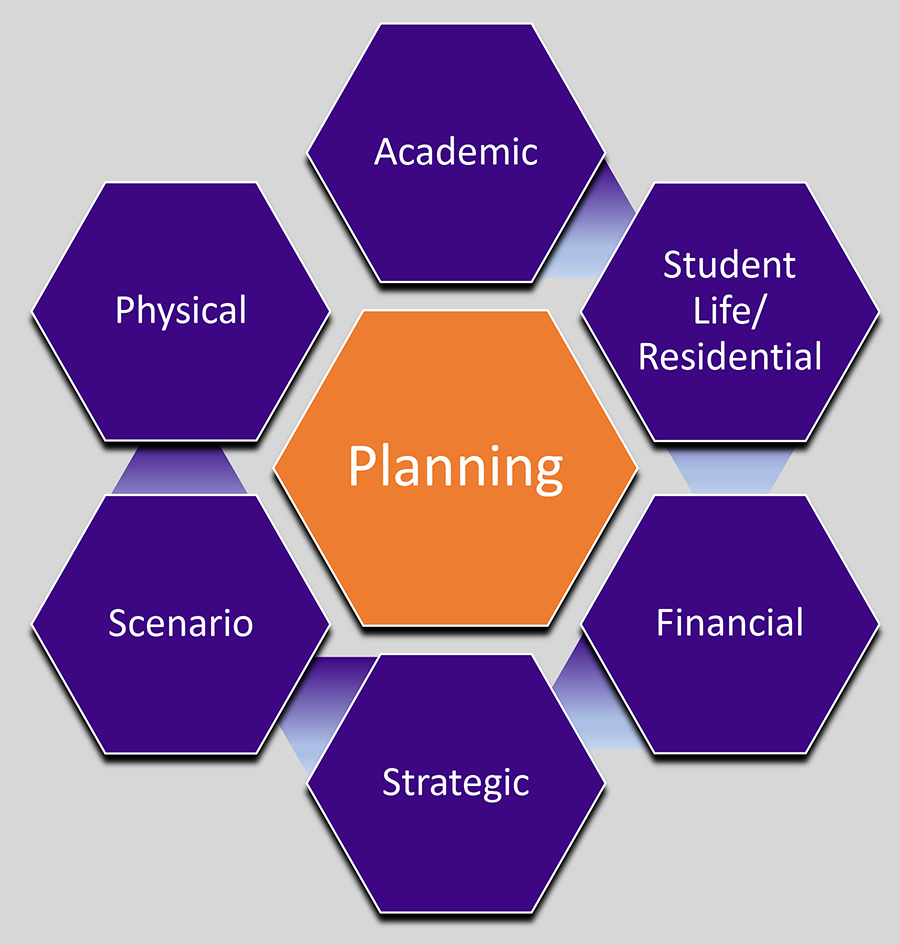Every decade it seems that experts expound on the higher education crisis du jour: fewer students in the pipeline, the decline of high school graduates, waning State financial support, emergence of MOOCs and online education, rapidly evolving technology, the pandemic, and institute closures and mergers. And yet, there are more colleges, universities, and for-profit educational institutions than in the past. However, to survive and flourish, colleges and universities must carefully plan their future.
Comprehensive campus planning is key – not just physical campus planning, but academic (curriculum, pedagogy, enrollment, staffing, research), campus/student life, operational, and financial. Not all comprehensive campus planning is effective, nor useful in supporting institutional survival.
There are many reasons why a campus plan is less effective than it should be. Although some of the blame could rest with the campus planner, the main reasons rest with the college or university itself – its culture and leadership. Here are 12 factors, any one of which can affect the effectiveness of campus planning. They do not have equal weight, and several are interrelated.
- Campus leaders that do not have a culture of planning
- Leaders that have not articulated an institutional vision for the future
- A poor strategic plan or no plan
- Planning occurs on campus to justify a specific project
- Leadership has difficulty prioritizing
- Lack of policies to encourage change
- There are conflicts on campus that hinder a participatory process
- Poor communications
- Lack of trust – with the president – with faculty
- Trustees involved in day-to-day decisions and operations
- Overly active alumni
- A significant donation with strings
The 1st barrier on the list – Campus leaders that do not have a culture of planning – is significant. The president, provost, or VP finance should be a champion for planning on campus – not just physical planning but planning in general. Planning here is broadly defined as academic planning (teaching and research), student life/residential planning, financial planning, strategic planning, scenario planning, and physical planning. All should be integrated using common and related data, and a consistent vison and set of goals. Planning is not episodic but should be continuous as the institutional environment changes – enrollment swings, funding availability, technology advances, pedagogical shifts, student needs, and economic fluctuations.

Plans must continuously be adjusted as they are implemented and the environment changes. There is a danger of becoming complacent.
The 2nd and 3rd barriers are fundamental and related. Without or with a poorly conceived vision and strategic plan, all institutional planning is limited, and a campus plan developed in this situation is nothing more than what an architect or campus planning consultant thinks the campus plan should be – an “artist’s rendition”. Without the vision of what leadership intends for the campus to become in the future, and without the strategic plan to realize that vision, there is really no way to plan for the future and create a campus plan that will allow the institutional vision to be realized.
Planning starts with a vision. What does leadership want the institution to be like in 10 years or perhaps 15 years.
One of the best vision statements is “Clemson will be one of the top 20 public universities within the next ten years.” It is concise, challenging, and inspiring. The goals to achieve that vision included teaching, research, and service. What are all the things that the University will have to change and improve to achieve this vision?
Compare Clemson’s vision to this: X Institution “….. will empower students by providing knowledge and skills to confidently navigate their future.”
This is not a vision statement. Nor is the next statement.
Y Institution “….. prepares and inspires individuals to explore widely, think critically, communicate clearly, and connect ideas creatively to
address our most challenging needs.”
Those “vision” statements are more like a mission statement – this is what we do. These “vision” statements are so generic that you can insert any college or university name.
Another barrier to an effective campus plan is the lack of, or poorly conceived strategic plan. Many strategic plans are simply statements of goals – often graphically and professionally produced. But no matter how beautiful they look, they are not plans, just goals. The important steps to realize their goals are missing or inadequate.
The characteristics of an effective strategic plan starts with a vision for the institution’s future; a set of goals to achieve the vision; strategies to realize each goal; a set of tasks for each strategy; identification of who is responsible for accomplishing each task; a timeline for completion of each task or strategy; metrics for measuring progress; a timeline for review and evaluation. This is a real plan.
The campus plan will use the vision and strategic plan to guide an analysis of the existing campus and to develop alternatives that address and support the various goals of the college or university.
The 4th barrier – planning occurs on campus to justify a specific project – is common, unfortunately. An example is a significant donation for a new building that is not an institutional priority, not in the campus plan, and not in the budget. Despite the gift, the institution will still be required to raise funds to complete the project. The real problem with this scenario is that the campus has not planned for it and will require a planning effort that probably will not be comprehensive.

The 5th barrier – Leadership has difficulty prioritizing – is actually related to the fourth barrier. Without a clear set of priorities, all projects are equally important – which can’t be.
The 6th barrier – Lack of policies to encourage change – can affect the entire campus. Colleges and universities are always balancing continuity and change. Change is a simple adjustment in the way an office does things. It is adopting new technology. It is a faculty introducing a new pedagogy. It is the addition of an academic program. It is the shift in direction of research. Change is always happening. The issue is whether it is encouraged and nurtured. The issue is whether it is planned and intentionally executed.
Barriers 7, 8, and 9 are interrelated: there are conflicts on campus that hinder a participatory process; poor communications; and lack of trust – with the president – with faculty – with the Board. A lack of transparency and inadequate communications lead to a lack of trust.
Communication and participation are essential for the development of a campus plan. The full range of a campus community needs to be involved from the janitor to the trustee and obviously include faculty, staff, and students. Participation means being actively involved and contributing, not just sitting in settings where findings and recommendations are reported out.

Trustees involved in day-to-day decisions and operations – the 10th barrier – has recently been making the news. In the past, it was because a trustee or two did not understand their management or fiduciary responsibilities. Now, it is political! This situation could affect funding, tenure, and academic freedom. Some boards are trying to control who can be hired by the campus, and what should be taught.
It is difficult to plan when an institution needs approval by an antagonistic board. It is an unhealthy situation.
The 11th barrier – Overly active alumni – It is nice to have active alumni who are supportive and encouraging. Where it becomes a problem is if the alumni are pushing their own agenda, different from the institution’s. This can warp the institution’s priorities, take time away from ongoing activities, and certainly have a deleterious impact on planning.
The last barrier a significant donation with strings – puts the institution in a difficult bind. On the one hand, a significant gift has positive implications for the institution and is hard to decline. On the other hand, there are strings attached that are important to the donor. A string might be having control over the hiring of certain faculty or disciplines. A string might be the hiring of a favorite architect. A string might be the creation of certain areas of research. If the string does not support the institution’s strategic plan, beware.


Arthur Lidsky
|





